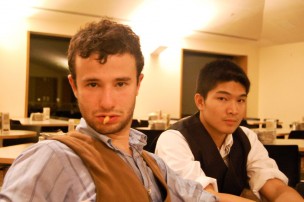
c/o Leonid Liu
“Come on, I’ll show you,” Leonid Liu ’14 offered, waving me forward through the doors on the far side of the Usdan lounge. Around two corners, to the left, we found it: the first wooden plaque of the brand-spanking-new Wesleyan scavenger hunt. We were following a path that Liu and Oren Finard ’14 had embarked on as a part of this new, student-created adventure.
The two students owed their scavenger hunt—and the two weeks of excitement, frustration, breakthroughs, and brain-teasers it entailed—to recent alum Jack Hoskins ’12.
Although he officially started planning the hunt near the end of his junior year, Hoskins developed his interest in scavenger hunts and similar adventures at a young age. Originally relying on his mother to organize hunts for him and his friends, Hoskins eventually took to making his own, though on a smaller scale than his most recent Wesleyan creation. The whole University scavenger hunt took nearly his entire senior year to put together. The final product reflects his intensive efforts—the hunt ranges all over the sprawling Wesleyan campus.
“It was easy to come up with simple clues,” Hoskins said. “But finding a way to present them elegantly was more difficult.”
The complexity of the clues has stumped many a Wesleyan student.
“The clues were of a unique and clever style that I hadn’t yet encountered,” Finard, also a childhood scavenger hunt aficionado, wrote in an email to The Argus.
The clues vary in difficulty. Liu and Finard were able to complete some in a manner of minutes, while otehrs were more challenging.
“[One clue had us] searching through Olin and around various landmarks on campus for five days,” Liu said.
The University proved a necessary and willing ally in Hoskins’ creation.
“Wesleyan seemed really into it; [the idea] really seemed to fit the personality of the school and provide another fun way for students and visitors to interact with the campus itself,” Hoskins said.
To bring his plan to fruition, he needed to submit proposals to the administration, gather funds, and obtain clearance for each plaque placement.
“[Director of Physical Plant] Cliff Ashton was a big help. . . I’d submit photos of sites I wanted to use to him [to get permission],” Hoskins said.
Many students have already embarked on the quest, including the numerous pioneers Hoskins brought in during the planning stages to test the difficulty of various clues. Wesleyan students came together for the inaugural hunt when Hoskins sent off a friend with the first clue and he was greeted several hours later by a group of 20 to 30 students who had all decided to join in on the fun.
Finard also appreciated the group aspect of the hunt.
“We’d often start out searching, just the two of us, but would end up with a party of five or so friends,” he wrote. “It wasn’t hard, especially since it was finals week and everyone wanted to procrastinate, to get people to just run around with us on a beautiful day.”
The first few groups who completed it were interested in a final, physical prize in addition to the bragging rights that come along with completion now. Hoskins created an ultimate, bonus clue for these few groups that led to a material reward. Since it wasn’t and isn’t a part of the official hunt, he focused especially on making this final clue exceedingly difficult, requiring some students to go so far as scaling buildings to access rooftops.
Now that he has graduated, Wesleyan students must rely on the plaques Hoskins has left behind to follow his journey. Although the scavenger hunt is still young, Finard believes that it will become a Wesleyan tradition. Liu urged all students to participate.